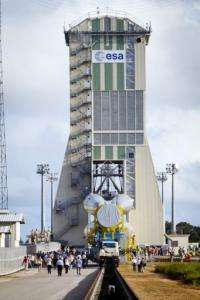Huge stakes riding on maiden Soyuz launch from Kourou

Prestige and a multi-billion-dollar gamble in satellite navigation will be riding on a Soyuz rocket next Thursday when the Soviet-era workhorse launches from Europe's space base in South America.
It will be the first time that the legendary rocket, which traces its lineage to Sputnik and Gagarin, has been deployed outside Russia's bases.
And its payload will be the first two operational satellites in Galileo, Europe's 5.4-billion-euro (7.2-billion-dollar) rival to the US Global Positioning System (GPS).
Soyuz is the world's most successful rocket, with a whopping 1,776 launches under its belt if the count includes forerunners dating back to 1957. There have been only 99 failures, yielding a success rate of 94.4 percent.
Until now, Soyuz has been launched from Plesetsk, in northern Russia, or from Baikonur, in Kazakhstan. Under a 2003 deal, Russia agreed to launch it from ESA's base in Kourou, French Guiana.
By launching its treasured child abroad, Russia gained precious income for its beleaguered space industry.
In exchange, Arianespace, which markets ESA's rockets for satellite launches, got a medium-range vehicle to go alongside the heavy Ariane 5, and a future lightweight rocket, the Vega.
"I have been pursuing this project for more than a decade. Now we really are in the home stretch," Arianespace boss Jean-Yves Le Gall told AFP on Friday.
Ultimately, "Arianespace will be the only operator in the world that will be able to launch any satellite, from the smallest to the biggest, and place it any orbit," he said.
A site has been specially built for Soyuz 12 kilometres (eight miles) from the Ariane launchpad. As a symbol of this unprecedented cooperation, it incorporates a rock brought from the Baikonur pad from where Yuri Gagarin made the first human spaceflight in 1961.

The infrastructure includes a 45-metre (146-feet) -high gantry to enable Soyuz launches. The site can be adapted for human spaceflight if need be, a noteworthy addition after the US shuttle's phaseout earlier this year.
The "Kourou" Soyuz has been given the designation Soyuz STK.
A spinoff of the Soyuz 2, it will use the Fregat upper stage and the ST nose cone, along with several minor modifications to make it compatible with ESA equipment.
Thursday's payload is as prestigious as it is valuable.
The European Union (EU) says Galileo will be far more accurate than the GPS and offer better coverage in cities, where sat-nav signals can be masked by buildings.
Above all, it means the world's biggest trade bloc will not have to depend on a foreign power for what is now an essential economic tool.
"Galileo springs from a European desire to be independent in geo-location with respect to America's GPS and Russia's Glonass" systems, said Claude Audouy of France's National Centre of Space Studies (CNES).
The "Soyuz STK" is different from the Soyuz U, which failed on August 24 while carrying a robot freighter to the International Space Station (ISS), Arianespace says.
That problem has been pinned to a failure on the Soyuz U's upper stage, which is different from the STK's Fregat.
From Kourou, Soyuz will be able to hoist 2.8 tonnes into geostationary transfer orbit, compared with 1.7 tonnes from Baikonur. The big difference in payload is explained by the extra push given by Earth's rotation at the Equator.
The Ariane 5 can place up to 9.5 tonnes in low Earth orbit. Vega, with a launch capacity of 1.5 tonnes to low Earth orbit, was due for its maiden flight in 2011 but this has been postponed to January 2012.
The first two Galileo satellites have been named Natalia and Thijs, after a nine-year-old Bulgarian girl and an 11-year-old Belgian boy, who won a drawing competition among European youngsters.
Liftoff is set for 7:34 a.m. (1034 GMT) on Thursday.
(c) 2011 AFP



















